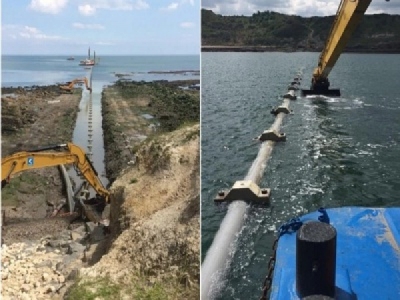
Posted on June 5, 2017
By Rakesh Soekhoe, (Product Specialist Liquidyne)
As a dredging company, you are paid for every cubic metre of dredging spoil. You work with strict deadlines. Every day that your dredge pump is idle costs you money. You want your dredger pump to run for as long as possible. Dredge pumps often have to cope with severe shocks and vibrations, the wrong alignment and/or an abrasive medium. The (Liquidyne®) pump shaft seals are specially designed to withstand events such as these. Choosing to add a settling pipe to the pump shaft seal protects the seal even more against wear. Read this blog to find out how this works.
Pump shaft seal for dredgers
The Liquidyne 3-Stage pump seal is used in pumps that process water containing a relatively large share of abrasive particles or particles larger than 100 micron. Lagersmit developed the Liquidyne 3-Stage WA especially for pumps in which the pump water is polluted. This seal is applied for instance in booster pumps, sewage pumps, dredge pumps and mining pumps, and offers all the Liquidyne advantages.
Self-regulating and self-cleaning alternative
The alternative for a regular filter is a settling pipe. A settling pipe is a self-regulating and self-cleaning filter developed to use outboard water as flush water for the Liquidyne seal. By using the already installed gland flush it is possible to use piping that is also already installed. This is a great advantage compared to a filter which needs to be cleaned and replaced regularly. The settling pipe is used as standard in the dredging applications, but can also be applied in other circumstances where a Liquidyne is installed.
How does it work
The settling pipe functions under specific circumstances:
– The flow through the gland flush line is 4,5 m/s, minimal 3 m/s.
– The flow speed through the settling pipe is regulated by the Liquidyne seal assembly itself. The flow is dependent on rotational speed and the pressure on the seal.
There is no need to force flushing water through the settling pipe. The pipe will regulate its own flow, meaning the pressure should be just below the water chamber pressure.
– The filter grade is linked with the flow through the pipe. For instance, a flow of 500 L/h results in a filter grade of 33 µm; a flow of 4000L/h results in 98 µm.
– The settling pipe must be installed at a 45° angle in respect to the horizontal gland flush line.
A correctly installed settling pipe is essential for the self-cleaning and regulating capacity of the pipe. A flow speed below 3 m/s in the gland flushing line results in a less stable flow in the pipe. Below 2 m/s the flow even becomes turbulent and the flow-out could reverse delivering more sand into the pipe, rendering the settling pipe useless.
When the settling pipe functions correctly it needs no maintenance, although some might choose to backflush the pipe after heavy use to clean out the pipe.





